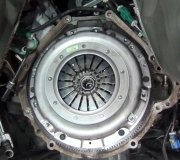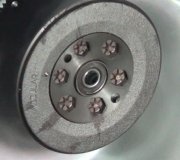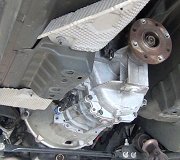Good morning,
I posted the description below that has some diagnostic aids to check. I also attached a flow chart. It could still be the throttle body as well.
I also posted the flow chart for the TPS as well.
This could be a bad throttle body. The bore for the idle air control may be carboned up holding it wide open.
Roy
CIRCUIT DESCRIPTION
The Idle Air Control (IAC) valve is located in the throttle body. The IAC valve consists of a movable pintle, driven by a gear attached to an electric motor called a stepper motor. The IAC valve motor is a 2-phase bi-polar permanent magnet stepper motor that is capable of highly accurate rotation, or movement, every time the polarity of a winding is changed. This change in polarity can be seen when observing a test lamp connected between ground or B+ and an IAC valve circuit while the Powertrain Control Module (PCM) is attempting to change engine RPM. The test lamp will flash on or off each time the polarity is changed. The PCM does not use a physical sensor to determine IAC pintle position, but uses a predicted number of counts, one count represents one change in polarity which equals one step of the stepper motor. The PCM counts the steps that have been commanded in order to determine the IAC pintle position. The PCM uses the IAC valve to control engine idle speed by changing the pintle position in the idle air passage of the throttle body. This varies the air flow around the throttle plate when the throttle is closed. In order to determine the desired position of the IAC pintle at idle or during deceleration, the PCM refers to the following inputs:
The engine RPM
The battery voltage
The air temperature
The engine coolant temperature
The throttle position sensor angle
The engine load
The vehicle speed
When the ignition key is turned OFF after an ignition cycle, the PCM will first seat the IAC pintle in the air bypass bore, and then retract the pintle a predetermined amount of counts in order to allow the proper amount of air to bypass the throttle plate for engine start-up. This procedure is known as an IAC Reset.
CONDITIONS FOR RUNNING THE DTC
DTCs P0101, P0102, P0103, P0106, P0107, P0108, P0112, P0113, P0117, P0118, P0121, P0122, P0123, P0125, P0201, P0202, P0203, P0204, P0205, P0206, P0207, P0208, P0335, P0336, P0340, P0341, P0385, P0386, P0401, P0403, P0404, P0405, P0440, P0442, P0443, P0446, P0449, P1106, P1107, P1111, P1112, P1114, P1115, P1121, P1122, P1336, P1372, P1404, or P1441 are not set.
The Engine Coolant Temperature (ECT) is greater than -40°C (-40°F).
The Intake Air Temperature (IAT) is greater than -18°C (-1°F).
The ignition voltage is between 10.5-16 volts.
The Barometric Pressure (BARO) is greater than 65 kPa.
The engine run time greater than 40 seconds.
The transmission gear state has not changed for 3 seconds.
The Torque Converter Clutch (TCC) state has not changed in 3 seconds.
The TPS less than 1.5 percent.
The spark advance is less than 12.39 degrees.
The spark retard is greater than -13.79 degrees.
The Vehicle Speed Sensor (VSS) is less than 3 km/h (1.9mph).
The above conditions are present for 3 seconds.
CONDITIONS FOR SETTING THE DTC
The actual engine speed is 100 RPM greater than the desired engine speed.
The above enabling criteria must be met and fail the diagnostic 3 consecutive times to set this DTC.
ACTION TAKEN WHEN THE DTC SETS
The control module illuminates the Malfunction Indicator Lamp (MIL) on the second consecutive ignition cycle that the diagnostic runs and fails.
The control module records the operating conditions at the time the diagnostic fails. The first time the diagnostic fails, the control module stores this information in the Failure Records. If the diagnostic reports a failure on the second consecutive ignition cycle, the control module records the operating conditions at the time of the failure. The control module writes the operating conditions to the Freeze Frame and updates the Failure Records.
CONDITIONS FOR CLEARING THE MIL/DTC
The control module turns OFF the Malfunction Indicator Lamp (MIL) after 3 consecutive ignition cycles that the diagnostic runs and does not fail.
A current DTC, Last Test Failed, clears when the diagnostic runs and passes.
A history DTC clears after 40 consecutive warm-up cycles, if no failures are reported by this or any other emission related diagnostic.
Use a scan tool in order to clear the MIL and the DTC.
DIAGNOSTIC AIDS
Inspect for the following conditions:
The correct PCV valve, properly installed, and proper operation of the PCV valve
Proper operation and installation of all air intake components
Proper installation and operation of the mass air flow sensor, if equipped
A tampered with or damaged throttle stop screw
A tampered with or damaged throttle plate, throttle shaft, throttle linkage, or cruise control linkage, if equipped
A skewed high TP sensor
Excessive deposits in the IAC passage or on the IAC pintle
Excessive deposits in the throttle bore or on the throttle plate
Vacuum leaks
A high or unstable idle condition could be caused by a non-IAC system problem that cannot be overcome by the IAC valve. Refer to Symptoms - Computers and Control Systems. See: Computers and Control Systems > Symptom Related Diagnostic Procedures
If the problem is intermittent, refer to Intermittent Conditions in Symptoms. See: Computers and Control Systems > Initial Inspection and Diagnostic Overview > Intermittent Conditions
Images (Click to make bigger)
Sunday, October 6th, 2019 AT 5:55 AM







